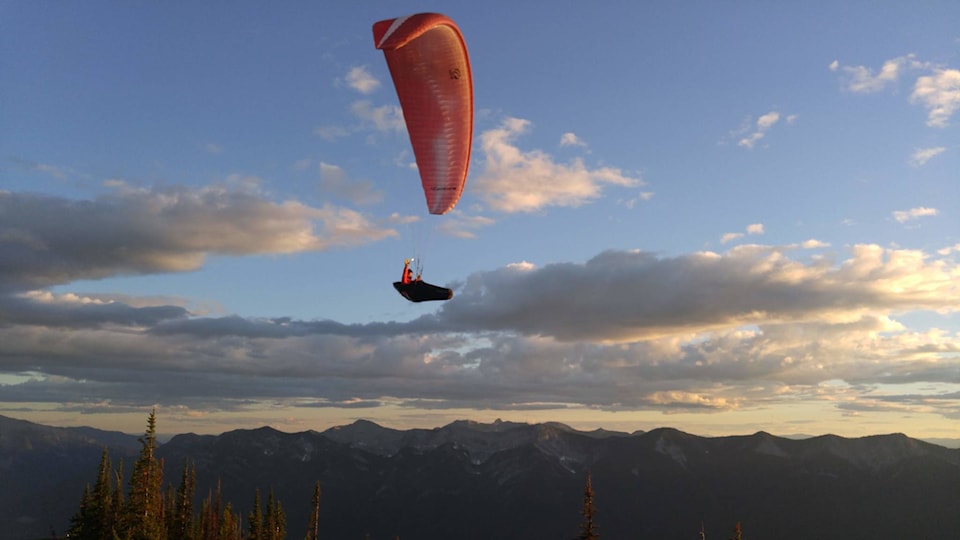There is a special kind of loneliness that only glider pilots seem to appreciate…climbing thousands of feet above the mountains in columns of rising air, suspended underneath engineered fabric, with only a small reserve parachute separating the pilot from injury or death if things go wrong. It’s a beautiful sport in spring, summer and fall for the small, but stalwart, group of Elk Valley paraglider pilots. And they are pilots. The current open distance world record cross-country flight in a paraglider is 588.27km, a tasked achieved in Brazil this October. Climbs over 10,000ft are common. But as winter arrives in the valley, hopes of soaring flights are usually abandoned in place of speed paragliding, a death defying fringe sport comprised of adrenalized aviators who barrel-roll through canyons of ice at 120km/hr.
Local tree planting contractor and Fernie resident Rainer Korn, who started paragliding decades ago, has not, as of yet, joined the ranks of hardcore speed paraglider pilots. He’s a dedicated soaring pilot with ratings from the Hang Gliding and Paragliding Association of Canada – like all other Elk Valley paraglider pilots. On Nov. 24, he and a small group from the local flying community hiked several hundred feet up Mt. Proctor, and, as they say in the foot-launch soaring world, skied-out. As cumulus clouds formed below the summit of area peaks, Korn and his friend, Zdenek Erban, managed to core the weak convective lift and gain enough altitude to touch the clouds and stay aloft for approximate two hours. Some might call it the result of climate change. Others might call it luck. But Korn and the other Fernie pilots are no slouches when it comes to airmanship. The group has installed high-tech, solar powered, ‘wind talkers’ on several area mountains. Through a smartphone application, they take the guesswork out of determining the right weather for soaring in the Elk Valley. For Korn and his intrepid comrades, who also fly with computerized flight-decks, the “N” in November stands for “no problem.”
“Yesterday was epic, because it was November,” he said. “And we’re actually going up [in thermals]. It was me Zdenek, Martin, and Ben. The lift was very light, but once you get above launch you just follow that ridge line up, and yesterday I got right back in the Three Sisters, but the cloud-base was pretty low, 2200m was as high as I got. My hands got super cold.”
Korn learned to fly paragliders in Bella Coola B.C. in the 1990s.
“I bought a little snowmobile so I could go backcountry touring,” he explains. “I ran into a couple of loggers who had a paraglider. So I just started chatting with them.”
The next thing he knew, he was making short flights in a square, old-school paraglider with a poor gliding angle and high take-off speed.
“They just strapped me up,” he says. “None of them were flying because there was no wind and they couldn’t run fast enough to get off the ground. I had skis, though, so they just pushed me down. And then they’d zip down in the snowmobile and pick me up.”
Korn moved to Fernie in 1999…“The houses were still cheap here back then.” But the move, and being one of the pioneers of paragliding in the Elk Valley, didn’t come without near misses.
“The flying here is actually quite exceptional,” he says. “I pounded-in twice at the microwave tower. Both times were quite similar. I was flying in the fall, which is quite surprising. The glider collapsed. It’s the way the ridge lines up in the fall. The sun hits one side really hard and the other side is shady. And you end up with these really hard bullet thermals. Very tight and very fast.
Luckily I skipped off the rock face and did a roll into a little patch of snow and walked away. My kite got all ripped up in the trees.”
Korn said that modern paragliders have better stability, and will recover from collapses without much, if any, pilot input.
“They are so much better and faster than the old wings,” he explains. “The new material is super light and the Kevlar lines are thin.”
The Elk Valley paragliding community is growing.
“From having one or two pilots,” he explained.
“Up to 12 who are really keen. Now a bunch of the young bucks, they are all speed flying too. They’ve got speed wings. This year a whole group of them went down to the Canadian Nationals in Pemberton. It’s exciting for me to see. It makes you enthusiastic again.”
Elk Valley paraglider pilots are a rare breed. An earthly version of Battlestar Galactica, a rag-tag fugitive fleet of sophisticated and nimble aviators who seek and find lonely places in the sky. If the wind is calm and the sun is out, look up. You might get lucky and see Rainer Korn and his friends – tiny specks circling into the heavens.
